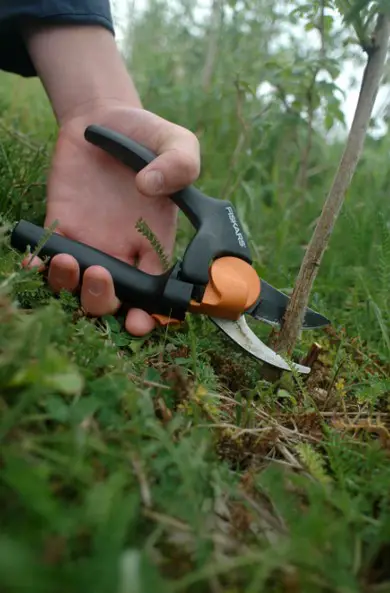Pruning your bushes, trees and shrubs has never been easier, but sometimes it’s hard to see exactly how. That’s because walking down the gardening tool aisle of the average home improvement store is like entering a hall of mirrors. Reality isn’t always as it seems. Sure, all the pruning gear looks great on the shelves, but how will it perform when you get home?
Ever since the weather got warm, I’ve been using the latest in garden tools, with a special emphasis on pruning equipment. Cutting off branches and limbs is important for optimizing trees and bushes, but it’s also where Canadian gardeners struggle the most. Wood is hard, and this can make pruning physically difficult unless you’re properly equipped.
 Gardena StarCut 160 BL
Gardena StarCut 160 BL
There’s been more than the usual amount of innovation in the pruning tool scene lately, and one of the best examples doesn’t look like anything special. In fact, until I used it, the Gardena StarCut 160 BL seemed rather silly:
- It’s a 62-inch-long straight staff with a set of swiveling pruner jaws at one end.
- There are no arms to work back and forth, just a small, plastic tee-handle.
- This handle is connected to the jaws by a woven cord, and this is where my doubts came from.
- The StarCut is rated to handle branches up to 1 1/2 inches thick, and I know from experience that it takes a lot of muscle to make a regular pair of scissor-style loppers chew through this much wood. So how could pulling down on a plastic handle ever live up to this same challenge?
With one cut the StarCut changed my mind. And it showed me something that I should have noticed before.
The Beauty of Leverage
- The genius behind the StarCut is leverage. That’s what I missed at first glance, and that’s what put a smile on my face the first time I used this tool.
- It takes a 19-inch long pull on the handle to make the jaws move 1 1/2 inches to close, and this is why the tool is so very easy to operate. Remarkably easy.
- Besides the fact that it let’s you reach and prune branches that are more than 10 feet high, the StarCut takes a very small amount of strength to use.
- In fact, on branches 3/4-inch in diameter or less, you hardly even know you’re cutting.
- The tool also has a secondary handle mounted in the middle of the tool for trimming shorter branches when you don’t need the full reach of the shaft.
My sixteen-year-old son has an unusual summer job. He manages 600 feet of pick-your-own raspberries we have, and that makes him something of an expert on hand-held pruners.
The biggest part of maintaining a raspberry patch is cutting away all the canes that bore fruit last year, and each spring Robert probably completes 7,000 or 8,000 individual snips making room for the new crop.
For years we’ve used traditional, hand-held pruning shears for this job, with no reason to expect we’d find anything better. But this spring Robert used a pair of Fiskars Power Gear pruners instead, just for comparison. Made mostly of plastic, these don’t look as impressive as the all-metal professional pruners we’ve used for years. But they do have an innovation that makes them less tiring to use. Much less tiring.
 Fiskars Power Gear
Fiskars Power Gear
Instead of an ordinary pair of rigid handles, the Fiskars has a swiveling bottom handle. It rotates as it pivots while you close the tool with your hand, and this action offers two benefits:
- Rolling eliminates friction between your fingers and the handle surface. The handle rolls with your skin instead of sliding against it, reducing blisters.
- The end of the rolling handle engages with the body of the pruners via a rack-and-pinion gear assembly. This feature converts the rolling action of the handle into additional slicing force at the jaws.
The bottom line is simple: the Fiskars are easier to use. I know because they’re the ones Robert grabs before crawling down raspberry rows after supper, snipping while he listens to his iPod.
Every year the world gains a few great gardening tools, and that’s a welcome thing. You’re not likely to have much fun in the garden without some good gear at your side, even if they do start off hidden in a sea of sensational mediocrity lining gardening aisles everywhere.
 Gardena StarCut 160 BL
Gardena StarCut 160 BL Fiskars Power Gear
Fiskars Power Gear


